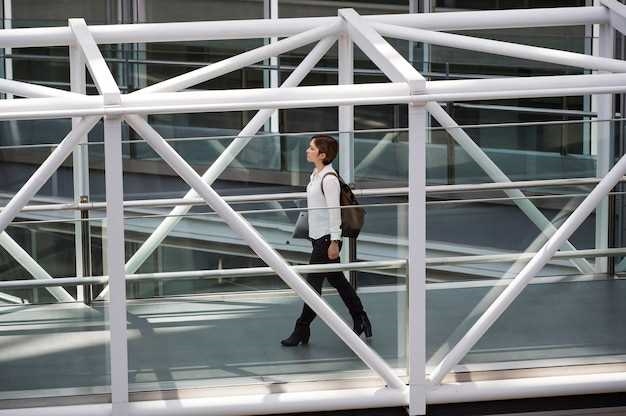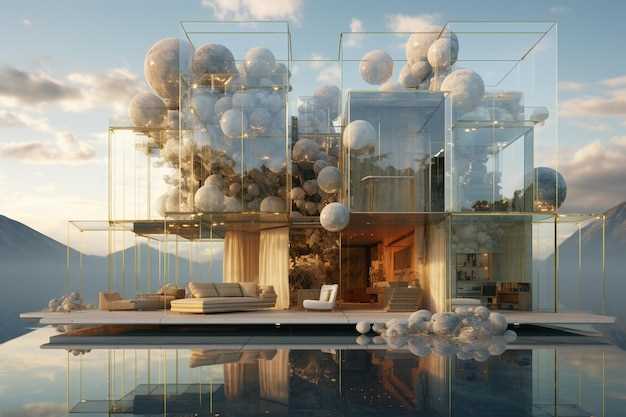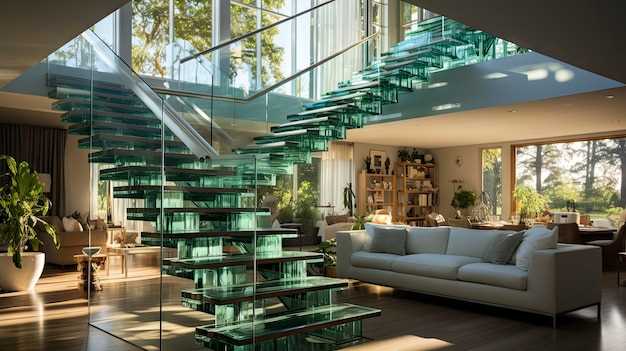

Step into a world where creativity and functionality merge seamlessly, where light dances and reflections mesmerize, and where the boundaries of design are constantly pushed. Welcome to the captivating realm of contemporary glass architecture and interior design.
With its timeless elegance and versatility, glass has become an essential element in modern design, revolutionizing the way we perceive and interact with our surroundings. From sleek skyscrapers to chic residential spaces, glass has transcended its traditional role as a mere building material and has evolved into a medium that inspires awe and wonder.
Embracing the principles of minimalism and transparency, glass architecture and interior design have redefined the concept of space, blurring the lines between indoor and outdoor environments. The use of glass walls, windows, and facades allows natural light to flood the interiors, creating a sense of openness and connection with the outside world.
But it is not just the practicality of glass that makes it so captivating. Its ability to transform and adapt to various styles and purposes is what truly sets it apart. Whether it’s a sleek and modern office space, a luxurious and opulent hotel lobby, or a cozy and intimate residential retreat, glass can be tailored to suit any aesthetic and functional requirement.
So, join us on a journey through the latest trends in glass architecture and interior design, as we explore the innovative techniques, breathtaking structures, and awe-inspiring creations that are shaping the future of design. Prepare to be inspired, amazed, and captivated by the endless possibilities that glass has to offer.
Embracing Transparency: The Rise of Glass Walls and Facades
In the realm of contemporary architecture and design, there has been a notable shift towards embracing transparency as a defining element. The use of glass walls and facades has become increasingly popular, revolutionizing the way spaces are perceived and experienced. This trend has brought about a new era of openness, lightness, and connectivity in both residential and commercial structures.
Sustainable Design: Incorporating Energy-Efficient Glass Solutions
In today’s ever-evolving world of architecture and design, the focus on sustainability has become paramount. As we strive to create spaces that are not only visually appealing but also environmentally friendly, the incorporation of energy-efficient glass solutions has emerged as a key trend. This section explores the concept of sustainable design and how it can be achieved through the use of innovative glass technologies.
When it comes to sustainable design, the goal is to minimize the negative impact on the environment while maximizing energy efficiency. Energy-efficient glass solutions play a crucial role in achieving this objective. By harnessing the power of natural light, these solutions reduce the need for artificial lighting, thus decreasing energy consumption and lowering carbon emissions.
One of the primary ways energy-efficient glass solutions contribute to sustainable design is through their ability to control solar heat gain. By incorporating low-emissivity coatings, these glasses can effectively reflect a significant portion of the sun’s heat, keeping interiors cooler during hot summer months. This reduces the reliance on air conditioning systems, resulting in substantial energy savings.
Furthermore, energy-efficient glass solutions also offer excellent insulation properties. By utilizing advanced glazing techniques and materials, these glasses can minimize heat transfer, preventing unwanted heat loss during colder seasons. This not only enhances the comfort of occupants but also reduces the need for heating systems, leading to further energy conservation.
In addition to their energy-saving benefits, these glass solutions also contribute to the overall well-being of occupants. By allowing ample natural light to penetrate interiors, they create a visually pleasing and uplifting environment. Studies have shown that exposure to natural light improves productivity, enhances mood, and promotes overall well-being.
In conclusion, sustainable design is a crucial aspect of modern architecture and interior design. By incorporating energy-efficient glass solutions, designers can create spaces that not only prioritize environmental responsibility but also enhance the comfort and well-being of occupants. The use of innovative glass technologies allows for the effective control of solar heat gain, insulation, and the utilization of natural light, resulting in significant energy savings and a more sustainable future.
Blurring Boundaries: The Integration of Indoor and Outdoor Spaces
In today’s ever-evolving world of architecture and design, there is a growing trend that seeks to break down the barriers between indoor and outdoor spaces. This innovative approach aims to create seamless transitions and harmonious connections, allowing nature to become an integral part of our built environment.
By blurring the boundaries between indoor and outdoor spaces, architects and designers are able to harness the beauty of natural light, the soothing sounds of nature, and the refreshing feel of the outdoors. This integration not only enhances the overall aesthetic appeal but also promotes a sense of well-being and connection to the environment.
One of the key techniques used in this design philosophy is the strategic use of glass. Glass, with its transparent and reflective properties, acts as a bridge that connects the interior and exterior worlds. It allows for unobstructed views, creating a sense of openness and spaciousness. Moreover, glass can be used to create dynamic and interactive spaces, where the boundaries between inside and outside become blurred.
Another aspect of this trend is the incorporation of natural elements within interior spaces. Living walls, indoor gardens, and water features are just a few examples of how nature can be brought indoors, blurring the line between the built environment and the natural world. These elements not only add visual interest but also contribute to improved air quality and a sense of tranquility.
Furthermore, the integration of indoor and outdoor spaces extends beyond residential architecture. Commercial buildings, such as offices and retail spaces, are also embracing this trend. By creating outdoor workspaces, rooftop gardens, and inviting courtyards, businesses are providing employees and customers with a refreshing and inspiring environment.
In conclusion, the integration of indoor and outdoor spaces is a trend that is revolutionizing the field of architecture and design. By blurring the boundaries between inside and outside, this approach creates a harmonious and immersive experience that connects us with nature and enhances our overall well-being.
Artistic Expressions: Exploring the Use of Decorative Glass Elements
In this section, we will delve into the realm of artistic expressions within the realm of glass design. We will explore the various ways in which decorative glass elements can be utilized to create stunning and unique architectural and interior designs. Through the use of innovative techniques and creative applications, these glass elements offer a wide range of possibilities for adding beauty, elegance, and artistic flair to any space.
Enhancing Aesthetics with Decorative Glass
Decorative glass elements provide an opportunity to elevate the aesthetics of any architectural or interior design project. By incorporating intricate patterns, textures, and colors, these elements can transform a space into a work of art. Whether it’s through the use of stained glass windows, etched glass partitions, or custom-designed glass sculptures, the possibilities for artistic expression are endless. These elements not only add visual interest but also create a sense of sophistication and elegance.
Functional and Versatile Applications

Decorative glass elements not only serve as artistic expressions but also offer functional and versatile applications. They can be used to create privacy screens, allowing natural light to filter through while maintaining a sense of seclusion. Glass partitions can be used to divide spaces without sacrificing openness and transparency. Additionally, glass can be used as a medium for displaying artwork or as a surface for writing or drawing, adding a unique touch to any interior design.
| Benefits of Decorative Glass Elements |
|---|
| Enhances aesthetics |
| Creates a sense of sophistication |
| Offers functional applications |
| Provides versatility in design |
| Allows for artistic expression |
Whether used in residential, commercial, or public spaces, decorative glass elements have the power to transform any environment into a visually captivating and artistically inspiring space. By exploring the various techniques and applications of these elements, designers and architects can push the boundaries of traditional glass design and create truly unique and breathtaking works of art.
Smart Glass Technology: Enhancing Functionality and Privacy
In the realm of contemporary architecture and interior design, there is a growing trend towards incorporating smart glass technology. This innovative solution offers a multitude of benefits, including enhanced functionality and privacy. By seamlessly integrating technology into glass surfaces, designers are able to create dynamic and adaptable spaces that cater to the needs and preferences of occupants.
Enhanced Functionality
One of the key advantages of smart glass technology is its ability to enhance functionality within a space. Traditional glass partitions or windows often limit the flexibility of a room, as they cannot be easily modified to adapt to changing requirements. However, with smart glass, the transparency of the glass can be controlled, allowing for instant privacy or openness at the touch of a button. This feature enables spaces to be transformed from private meeting rooms to open collaborative areas, providing a versatile environment that can be tailored to specific activities.
Privacy Enhancement
Privacy is a crucial aspect of any interior space, whether it’s an office, a hotel room, or a residential setting. Smart glass technology offers a unique solution to privacy concerns by providing the ability to switch between transparent and opaque states. This allows individuals to enjoy unobstructed views when desired, while also ensuring privacy when needed. By eliminating the need for curtains or blinds, smart glass provides a sleek and modern alternative that maintains the aesthetic integrity of the space.
Furthermore, smart glass can be integrated with smart home systems, allowing for automated control based on predetermined settings or user preferences. This level of customization ensures that privacy is maintained without compromising convenience or comfort.
- Dynamic and adaptable spaces
- Instant privacy or openness
- Versatile environment
- Switch between transparent and opaque states
- Sleek and modern alternative to curtains or blinds
- Integration with smart home systems
In conclusion, smart glass technology is revolutionizing the field of architecture and interior design by enhancing functionality and privacy. Its ability to create dynamic and adaptable spaces, as well as provide instant privacy or openness, makes it a valuable tool for designers seeking innovative solutions. With the integration of smart glass, spaces can be transformed into versatile environments that cater to the needs and preferences of occupants, while maintaining a sleek and modern aesthetic.
Beyond Clear: Exploring the Versatility of Frosted and Textured Glass

Unveiling the Boundless Potential: Exploring the Diverse Applications of Frosted and Textured Glass
When it comes to glass, there is more than meets the eye. Beyond the traditional clear glass, frosted and textured glass have emerged as captivating alternatives that offer a world of possibilities in architecture and interior design. These innovative glass options provide a unique blend of functionality and aesthetics, allowing designers to create stunning spaces that are both visually striking and practical.
Embracing the Art of Obscurity: The Allure of Frosted Glass
Frosted glass, with its translucent and blurred appearance, adds an element of mystery and intrigue to any space. By diffusing light and obscuring visibility, frosted glass offers privacy without compromising on natural illumination. Its versatility knows no bounds, as it can be used in various applications, from sleek office partitions to elegant shower enclosures. With the ability to be customized with patterns and designs, frosted glass becomes a canvas for artistic expression, transforming ordinary surfaces into captivating focal points.
Textured Glass: A Touch of Elegance and Depth
Textured glass takes glass design to a whole new level by introducing captivating patterns and textures. From subtle etchings to bold geometric designs, textured glass adds depth and character to any space. Its tactile nature invites touch and creates a sensory experience, making it a popular choice for feature walls, decorative panels, and even furniture. The interplay of light and shadow on textured glass surfaces creates a mesmerizing visual effect, enhancing the overall ambiance of a room.
Unleashing Creativity: Endless Possibilities with Frosted and Textured Glass
By exploring the versatility of frosted and textured glass, designers can unleash their creativity and push the boundaries of glass architecture and interior design. These unique glass options offer a multitude of applications, from creating private yet luminous spaces to adding a touch of elegance and sophistication. Whether used in residential or commercial settings, frosted and textured glass have the power to transform ordinary environments into extraordinary works of art.